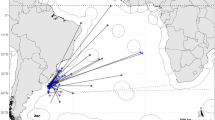Abstract
We examined a population of blacktip sharks, Carcharhinus limbatus, within a coastal nursery area to define how individuals use the nursery habitat throughout the summer. We used a series of acoustic hydrophones to passively monitor the movement patterns of sharks for periods up to 167 days. We used passive monitoring data to calculate home range estimates using minimum convex polygon (MCP) and fixed kernel estimators. MCP calculated the extent of an individual's range. Kernel estimates provided information regarding the utilization of space within the home range including core area (50% kernel) and larger excursions outside the core area (95% kernel). Individuals within the nursery area typically used a consistently small core area. All sharks monitored in the study site underwent a home range expansion during the month of July, suggesting a synchronous population-level change in habitat use. This change in habitat use was reflected in all home range calculations. Passive monitoring revealed that young sharks remain within the nursery area for up to 6 months. The long-term use of this nursery area reflects its critical importance to young blacktip sharks.
Similar content being viewed by others
References
Carey, F.G. & J.V. Scharold. 1990. Movements of blue sharks (Prionace glauca) in depth and course. Mar. Biol. 106: 329–342.
Castro, J.I. 1993. The shark nursery of Bulls Bay, South Carolina, with a review of the shark nurseries of the southwestern coast of the United States. Environ. Biol. Fish. 38: 37–48.
Castro, J.I. 1996. Biology of the blacktip shark, Carcharhinus limbatus, off the southeastern United States. Bull. Mar. Sci. 59: 508–522.
Cooper, W.E. Jr. 1978. Home range criteria based on temporal stability of area occupation. J. Theoret. Biol. 73: 687–695.
Eckert, S.A. & B.S. Stewart. 2001. Telemetry and satellite track-ing of whale sharks, Rhincodon typus, in the Sea of Cortez, Mexico, and the North Pacific Ocean. Environ. Biol. Fish. 60: 299–308.
Gruber, S.H., D.R. Nelson & J.F. Morrissey. 1988. Patterns of activity and space utilization of lemon sharks, Negaprion brevirostris, in a shallow Bahamian lagoon. Bull. Mar. Sci. 43: 61–76.
Heupel, M.R. & R.E. Hueter. 2001. Use of an automated acous-tic telemetry system to passively track juvenile blacktip shark movements. pp. 217–236. In: J.R. Sibert & J.L. Nielsen (ed.) Electronic Tagging and Tracking in Marine Fisheries, Kluwer Academic Publishers, Netherlands.
Heupel, M.R. & R.E. Hueter. 2002. Importance of prey density in relation to the movement patterns of juvenile blacktip sharks (Carcharhinus limbatus) within a coastal nursery area. Mar. Freshw. Res. 53: 543–550.
Heupel, M.R., C.A. Simpfendorfer & R.E. Hueter. 2003. Running before the storm: Blacktip sharks respond to falling barometric pressure associated with Tropical Storm Gabrielle. J. Fish Biol. 63: 1357–1363.
Holland, K.N., C.G. Lowe, J.D. Peterson & A. Gill. 1992. Tracking coastal sharks with small boats: Hammerhead shark pups as a case study. Aust. J. Mar. Freshw. Res. 43: 61–66.
Holland, K.N., B.M. Wetherbee, J.D. Peterson & C.G. Lowe. 1993. Movements and distribution of hammerhead shark pups on their natal grounds. Copeia 1993: 495–502.
Holts, D.B. & D.W. Bedford. 1993. Horizontal and vertical move-ments of the shortfin mako shark, Isurus oxyrinchus, in the Southern California Bight. Aust. J. Mar. Freshw. Res. 44: 901–909.
Morrissey, J.F. & S.H. Gruber. 1993. Home range of juvenile lemon sharks, Negaprion brevirostris. Copeia 1993: 425–434.
Nelson, D.R. 1990. Telemetry studies of sharks: A review, with applications in resource management. NOAATechnical Report NMFS 90: 239–256.
Simpfendorfer, C.A., M.R. Heupel & R.E. Hueter. 2002. Esti-mation of short-term centers of activity from an array of omnidirectional hydrophones, and its use in studying animal movements. Can. J. Fish. Aquat. Sci. 59: 23–32.
Spencer, S.R. & G.N. Cameron. 1990. Operationally defining home range: Temporal dependence exhibited by hispid cotton rats. Ecology 71: 1817–1822.
Sundstr¨om, L.F., S.H. Gruber, S.M. Clermont, J.P.S. Correia, J.R.C. de Marignac, J.F. Morrissey, C.R. Lowrance, L. Thomassen & M.T. Oliveira. 2001. Review of elasmobranch behavioral studies using ultrasonic telemetry with special reference to the lemon shark, Negaprion brevirostris, around Bimini Islands, Bahamas. Environ. Biol. Fish. 60: 225–250.
Voegeli, F.A., M.J. Smale, D.M. Webber, Y. Andrade & R.K. O'Dor. 2001. Ultrasonic telemetry, tracking and auto-mated monitoring technology for sharks. Environ. Biol. Fish. 60: 267–281.
West, G.J. & J.D. Stevens. 2001. Archival tagging of school shark, Galeorhinus galeus, in Australia: Initial results. Environ. Biol. Fish. 60: 283–298.
Author information
Authors and Affiliations
Corresponding author
Rights and permissions
About this article
Cite this article
Heupel, M.R., Simpfendorfer, C.A. & Hueter, R.E. Estimation of Shark Home Ranges using Passive Monitoring Techniques. Environmental Biology of Fishes 71, 135–142 (2004). https://doi.org/10.1023/B:EBFI.0000045710.18997.f7
Issue Date:
DOI: https://doi.org/10.1023/B:EBFI.0000045710.18997.f7




